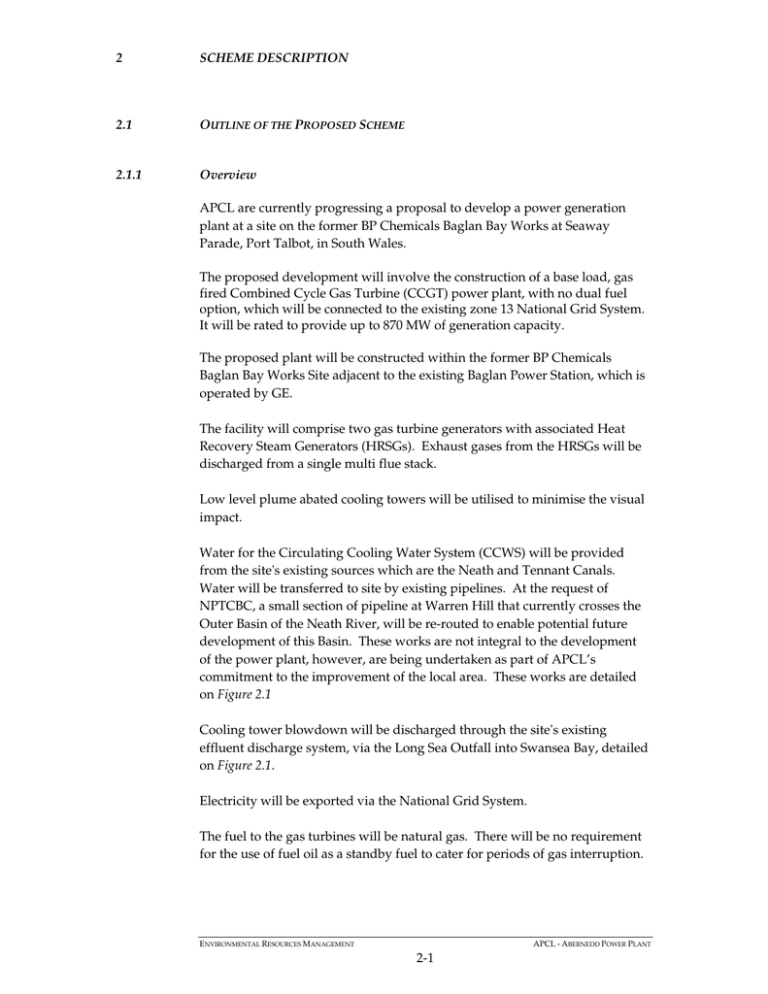
2
SCHEME DESCRIPTION
2.1
OUTLINE OF THE PROPOSED SCHEME
2.1.1
Overview
APCL are currently progressing a proposal to develop a power generation
plant at a site on the former BP Chemicals Baglan Bay Works at Seaway
Parade, Port Talbot, in South Wales.
The proposed development will involve the construction of a base load, gas
fired Combined Cycle Gas Turbine (CCGT) power plant, with no dual fuel
option, which will be connected to the existing zone 13 National Grid System.
It will be rated to provide up to 870 MW of generation capacity.
The proposed plant will be constructed within the former BP Chemicals
Baglan Bay Works Site adjacent to the existing Baglan Power Station, which is
operated by GE.
The facility will comprise two gas turbine generators with associated Heat
Recovery Steam Generators (HRSGs). Exhaust gases from the HRSGs will be
discharged from a single multi flue stack.
Low level plume abated cooling towers will be utilised to minimise the visual
impact.
Water for the Circulating Cooling Water System (CCWS) will be provided
from the site's existing sources which are the Neath and Tennant Canals.
Water will be transferred to site by existing pipelines. At the request of
NPTCBC, a small section of pipeline at Warren Hill that currently crosses the
Outer Basin of the Neath River, will be re-routed to enable potential future
development of this Basin. These works are not integral to the development
of the power plant, however, are being undertaken as part of APCL’s
commitment to the improvement of the local area. These works are detailed
on Figure 2.1
Cooling tower blowdown will be discharged through the site's existing
effluent discharge system, via the Long Sea Outfall into Swansea Bay, detailed
on Figure 2.1.
Electricity will be exported via the National Grid System.
The fuel to the gas turbines will be natural gas. There will be no requirement
for the use of fuel oil as a standby fuel to cater for periods of gas interruption.
ENVIRONMENTAL RESOURCES MANAGEMENT
APCL - ABERNEDD POWER PLANT
2-1
Cooling
Water
Pipeline
Existing
Effluent
Discharge
System
.
300
Metres
KEY:
Site
New Pipeline
Existing Pipeline
Redundant Pipeline
Existing Pipeline to be Upgraded
CLIENT:
APCL
SIZE:
A4
ERM
Llandarcy House
11A The Courtyard
Llandarcy
Swansea Bay, SA10 6EJ
Tel: 01792 814907
Fax: 01792 817396
SOURCE: Reproduced from Ordnance Survey digital map data. © Crown
copyright, All rights reserved. 2008 License number 0100031673.
PROJECTION: British National Grid
TITLE:
Figure 2.1
Associated Pipelines
DATE: 29/05/2008 CHECKED: PW
PROJECT: 0064142
DRAWN: CO
SCALE: 1:15,000
DRAWING:
APPROVED: SD
Associated_Pipelines.mxd
REV:
© ERM This print is confidential and is supplied on the understanding that it will be used only as a record to identify or inspect parts, concepts or designs and that it is not disclosed to other persons or to be used for construction purposes without permission.
1
File: 0064142BaglanBayGIS\mxds\NewB oundary_ES\Associated_Pipelines.mxd
0
2.1.2
Proposed Structures
The key physical structures associated with the project are:•
•
•
•
•
•
2.1.3
a turbine hall containing the gas (GT) and steam (ST) turbine(s);
a Heat Recovery Steam Generator (HRSG) associated with each GT power
train;
a single concrete multi-flue stack;
low profile plume abated cooling towers (LPPACT’s);
an outdoor switchyard and
an administration building, control room, amenities, stores and
workshops.
Power Plant Site
The site for the proposed power plant is located within the NPTCBC
administrative area, to the south of the existing GE power plant which is a
nominal 500 MW CCGT power plant, presently owned and operated by GE.
The proposed power plant will be contained within the larger and former BP
Chemicals Works site at Baglan. The site is predominantly flat and comprises
circa 600 mm of blast furnace slag and chippings overlaying circa 25 m of sand
with boulder clay “rockhead”. The former BP Chemicals plant and buildings
have now been demolished leaving a few electrical substations, and the
former internal site roads and infrastructure. Most of the former buried
services have been isolated and made redundant but there remains some
electrical and Towns Water and other service infrastructure which may
require some minor relocation as part of this proposed development. Such
works do not impact any operations external to the former BP Chemicals site.
The site has excellent road access from the M4, at Junction 41 and then via the
Baglan Energy Park adopted highway. This is the same route that was used
during the construction of the existing GE Power Station.
Figure 2.2 shows the area proposed for the CCGT site, Figure 2.3 shows a basic
plant layout.
ENVIRONMENTAL RESOURCES MANAGEMENT
APCL - ABERNEDD POWER PLANT
2-3
CLIENT:
Site Footprint
APCL
SIZE:
TITLE:
A4
ERM
Llandarcy House
11A The Courtyard
Llandarcy
Swansea Bay, SA10 6EJ
Tel: 01792 814907
Fax: 01792 817396
SOURCE: Unspecified
PROJECTION: British National Grid
© ERM This print is confidential and is supplied on the understanding that it will be used only as a record to identify or inspect parts, concepts or designs and that it is not disclosed to other persons or to be used for construction purposes without permission.
Figure 2.2
Site Footprint
DATE: 29/05/2008 CHECKED: SL
PROJECT: 0064142
DRAWN: CO
SCALE: NTS
APPROVED: SD
DRAWING:
SiteFootprint2.2.mxd
REV:
0
File: 0064142BaglanBayGIS\mxds\NewBoundary_ES\SiteFootprint2.2.mxd
KEY:
FIGURE 2.3
Plant Layout
2.2
PROCESS DESCRIPTION
2.2.1
Introduction
A CCGT plant is a highly efficient mode of generating electricity. This higher
efficiency is attained primarily through the combination of a gas turbine with
a steam turbine to recover and use the exhaust heat generated by the former.
The main process stages of the proposed CCGT are explained below.
2.2.2
Gas Turbines
Natural gas, supplied from the existing Transco network, will be used as the
fuel source to supply the gas turbines contained within the enclosed
machinery hall. Each of the gas turbines will draw combustion air from the
atmosphere via intake filters to remove particulate matter that might
otherwise damage the internal components of the machine. Fuel gas, mixed
with combustion air, is injected into the combustion chamber of the gas
turbine, where it burns to produce hot, high pressure, gases. These are
expanded through a power turbine which drives the compressor and electrical
generator.
The gas turbine power plant generally comprises a turbine compartment,
accessory compartment and inlet and exhaust systems. The turbines are
equipped with electric starting motors, or static frequency converters, and are
located indoors to reduce the noise emanating from the site. The exhaust
arrangement includes silencing and ducting. Combustion gases exit from the
exhaust system to the HRSG(s).
2.2.3
Heat Recovery Steam Generators
An HRSG is provided for each gas turbine. Each of the units comprises
separate steam circuits, complete with all necessary integral pipework,
equipment and instrumentation required for the safe and efficient operation of
the plant. The exhaust gases from the gas turbines pass through the HRSGs
where heat is extracted to raise and superheat steam. Exhaust gases are
subsequently discharged to atmosphere via a single multi flue stack.
The height of the stack required to ensure adequate dispersal is assumed to be
of the order of 90m, but the precise height will be agreed with the
Environment Agency during the PPC process. For the purposes of this EIA,
the stack height has been assessed at 90m.
2.2.4
Steam Turbines
Steam from the HRSG is conveyed to the steam turbine which is provided
with multiple admission points, one for each pressure level. The turbine itself
will probably comprise a high pressure cylinder and double flow, low
pressure cylinders. This steam turbine subsequently drives an electrical
generator similar to those driven by the gas turbines.
ENVIRONMENTAL RESOURCES MANAGEMENT
APCL - ABERNEDD POWER PLANT
2-7
The steam discharged from the steam turbine is condensed and then
recirculated back to the HRSG and reconverted back to steam.
2.2.5
Condenser Cooling
Cooling for the steam turbine condensers will be provided by a circulating
water system incorporating two banks of hybrid cooling towers.
2.2.6
Water Source and Discharges
The cooling water for the power plant will be provided from the site's existing
supply: the Neath and Tennant Canals. All appropriate abstraction licenses
will be obtained by APCL prior to operation. Some works will be required to
the existing pipeline from the Neath Canal. These will include upgrading and
re-routing of a short section of the pipeline (refer to Figure 2.1).
Expelled cooling water will be discharged into Swansea Bay via the existing
Long Sea Outfall. Minimal connection works only will be required to the
existing outfall and all licenses will be agreed with the Environment Agency
Wales (EAW) prior to discharge.
2.2.7
Water Demineralisation Plant
The condensed steam is returned via a deaerator and feed system, back to the
waste heat recovery boiler in a closed loop steam cycle. System losses will be
replenished by high purity make-up water produced by an on-site
demineralisation plant using towns water as the raw feed.
Treated effluents from this demineralisation unit will be neutralized and then
disposed to process drain.
2.2.8
Fuel Supplies
The proposed plant will utilise the existing buried underground natural gas
pipeline from national Grid Transco’s pipeline on the mountain above Tonna
to the north west of the site, to transport gas to the Baglan site. Natural gas is
a clean fuel and does not produce the particulate emissions associated with
burning coal or oil; consequently flue gas cleaning equipment is not required.
Natural gas will be supplied directly to an on-site gaseous fuel conditioning
area, where the pressure is regulated to match that required by the gas
turbines.
2.2.9
Electrical Power Transmission
The plant will be connected into the existing 275 kV National Grid, substation
on the Baglan Site. There may be a requirement for new overhead power lines
but this is outside the scope of this EIA and should this be required, any
potential impacts will be assessed separately as part of a Section 37 of the
ENVIRONMENTAL RESOURCES MANAGEMENT
APCL - ABERNEDD POWER PLANT
2-8
Electricity Act, 1989, Application. However, to support this EIA, an initial
desk based assessment has been undertaken in order to provide an indication
of the likely significant environmental impacts of these associated works,
which is reported in Chapter 14 of this ES.
2.2.10
Materials Handling Utilities and Infrastructure
During normal operation a range of products will be delivered to the power
plant. Natural gas and canal water will be imported by pipelines and others
(such as machinery lubricating oil, spare parts) will be delivered by road in
drums and packages. Most of these shipments will be stored in an amenities
and storage area.
The following utility systems will be provided:
•
Water to supply the demineralisation plant will be supplied by a raw
water pipeline from the towns water system.
•
Cooling water make-up will be drawn from the Neath and Tennant
Canals, via the existing pumping stations.
•
The fire extinguishing system for the proposed CCGT power plant will
consist of:
•
•
•
•
a hydrant main;
a wet pipe sprinkler system over the large transformers, the steam
turbine house, stores areas, and other possible oil leakage areas;
a carbon dioxide (CO2) system in electrical equipment rooms; and
a CO2 system in the gas turbine compartments.
Areas with no extinguishing systems will be fitted with an automatic fire
annunciating system, and buildings will be appropriately located to facilitate
connections to on-site firewater mains with fire water piping for the use of the
local fire brigade.
2.3
EMISSIONS TO THE ENVIRONMENT
2.3.1
Air Emissions
The principal emission to the atmosphere will arise from the process of
natural gas combustion in the gas turbines: the main stacks will be sources of
oxides of nitrogen (NO and NO2) and carbon dioxide (CO2). Carbon dioxide
is the most important of the greenhouse gases and is believed to contribute
more than half to global warming effects. Gas combustion from a CCGT
power plant produces approximately 57% of the CO2 per unit of energy
generated when compared with coal combustion. This is due to the higher
thermal efficiency achieved by CCGT power plant and the greater specific
energy content of the gas.
ENVIRONMENTAL RESOURCES MANAGEMENT
APCL - ABERNEDD POWER PLANT
2-9
Plant emissions will comply with the requirements of the Environment
Agency Wales, as determined by the PPC process. Chapter 12, Air Quality
presents an assessment of the likely environmental impacts associated with
the current proposals.
2.3.2
Liquid Emissions
Cooling waters will be discharged through the Dwyr Cymru Welsh Water
(DCWW) existing pipeline which extends approximately 2 km offshore into
Swansea Bay. Such a discharge would be subject to approval through the PPC
licensing system, under the Pollution Prevention and Control Regulations,
2000.
Four other discharges will also arise as a result of the operational facility:
•
•
•
•
2.3.3
surface drainage water discharge from site;
foul drainage from sources such as sanitary waters;
neutralised effluent from the demineralisation plant; and
process water discharge from the water/steam circuits.
Solid Wastes
Solid wastes will arise during the construction and operation of the CCGT
power plant. Where appropriate these wastes will be collected and disposed
of by licensed waste disposal contractors.
2.4
PROJECT PHASING
The power plant will be constructed in two stages.
Stage 1 will comprise:
•
•
•
•
•
•
GT/Generator 1, HRSG 1, the steam turbine/generator, electrical and
mechanical balance-of-plant equipment and systems (part);
the fuel gas compressor, the fuel gas above ground installation (AGI);
the water treatment plant (part), raw and treated water storage tanks, the
cooling water systems;
GT Generator Transformer 1, electrical switchgear and electrical and
control systems (part), electrical substation works;
all buildings and site facilities including control room facilities; and
all sub-surface works including excavations, piling works, foundations,
civil and drainage systems works.
Stage 2 will comprise:
•
GT/Generator 2, HRSG 2, electrical and mechanical balance-of-plant
equipment and systems (balance);
ENVIRONMENTAL RESOURCES MANAGEMENT
APCL - ABERNEDD POWER PLANT
2-10
•
•
the water treatment plant (balance); and
GT Generator Transformer 2, electrical switchgear and electrical and
control systems (balance).
This ES reports the likely significant environmental impacts from both stages
of development.
The construction schedule for the new plant is dependant on the date when
National Grid can achieve the connection to the grid system and effect export
from the Baglan site. This connection date currently set as follows:
•
•
Stage 1 = 435MW October 2013 ; and
Stage 2 = 870MW October 2016.
Assuming an Autumn 2013 grid connection date, the indicative high level
project programme milestones for stage 1 will be:
•
•
•
•
•
•
•
•
main contract award – spring 2011;
site mobilisation – summer/autumn 2011;
ground preparation works – summer / autumn 2011
piling & foundation works – autumn 2011 to spring 2012;
installation & construction of Stage 1 plant and equipment – spring 2012
to summer 2013;
commissioning & testing - autumn 2013;
partial site demobilisation – autumn / winter 2013; and
Stage 1 plant in commercial operation – autumn 2013.
The total construction period for Stage 1 will be approximately 30 months.
Assuming an Autumn 2016 grid connection date, the indicative high level
project programme milestones for Stage 2 will be:
•
•
•
•
•
•
•
•
main contract award – spring 2011;
ground preparation works – summer / autumn 2011
piling & foundation works – autumn 2011 to spring 2012;
site remobilisation – summer/autumn 2015;
installation & construction of Stage 2 plant and equipment - autumn 2015
to summer 2016;
commissioning & testing - autumn 2016;
site demobilisation – autumn / winter 2016; and
Stage 2 plant in commercial operation – autumn 2016.
The total construction period for Stage 2 will be approximately 18 months.
Figure 2.4 depicts the project programme. As illustrated, the entire contractual
period for the project, from site mobilisation of Stage 1 to site demobilisation
of Stage 2, is 54 months.
ENVIRONMENTAL RESOURCES MANAGEMENT
APCL - ABERNEDD POWER PLANT
2-11
The major project activities are broken into the following phases.
•
Site preparation and preliminary work. This comprises land clearance,
levelling of the site earthworks, construction of the site roads,
installation of drainage system, temporary facilities for the main
contractors workforce, and construction of laydown areas and access
roads. A period of approximately six months is required for this phase
of work.
•
The main construction. This encompasses the laying of plant
foundations, erection of all above ground structures and installation of
plant. A period of approximately eighteen months is allowed for this
phase.
•
Commissioning and reliability tests. Independent commissioning tests
will be undertaken by the contractor to ensure the plant meets all
specifications. A period of approximately six months for each of the two
stages is allowed for this phase.
ENVIRONMENTAL RESOURCES MANAGEMENT
APCL - ABERNEDD POWER PLANT
2-12
Figure 2.4 Project Programme
STAGE
PROJECT TIMELINE
2011
2012
2013
2014
2015
2016
QTR 1 QTR 2 QTR 3 QTR 4 QTR 1 QTR 2 QTR 3 QTR 4 QTR 1 QTR 2 QTR 3 QTR 4 QTR 1 QTR 2 QTR 3 QTR 4 QTR 1 QTR 2 QTR 3 QTR 4 QTR 1 QTR 2 QTR 3 QTR 4
Main Contract Award (for both stages of build),
Site Mobilisation (for the first stage of build) and Ground Preparation
Works (for both stages of build),
Excavations, Piling, Foundation, Drainage, Civil and Building Works
(for both stages of build),
Installation and Construction of first stage plant and equipment,
Commissioning and Testing of first stage plant and equipment
Partial Site Demobilisation (leaving skeleton contractor's team on site)
Stage 1 plant and equipment in commercial operation
Site Remobilisation (for the second stage of build),
Installation and Construction of second stage plant and equipment,
Commissioning and Testing of second stage plant and equipment,
Site Demobilisation,
Stage 2 plant and equipment joins stage 1 plant and equipment in
commercial operation.
2.5
HEALTH, SAFETY AND HAZARDS ISSUES
2.5.1
Overview
The health and safety of the workforce and local population is considered by
both APCL and the various authorities to be of paramount importance in the
design, construction and operation of the plant. Hence, potential hazards
presented by the installation have been considered by APCL and appropriate
design measures will be taken and operating procedures will be written to
mitigate and manage any risk involved.
The developer's statutory responsibilities include ensuring the safe design of
plant and apparatus, and the provision and maintenance of safe and healthy
working conditions, equipment and systems of work for all of its employees,
and for the health and safety of other people who may be affected by its
activities. This responsibility arises from the requirements of various Acts of
Parliament and government regulations including the Health and Safety at
Work etc Act 1974, The Factories Act 1961, the Electricity Regulations 1908 and
1944, The Electricity Supply Regulations 1988, the Electricity Supply
Regulations 1988, Noise at Work Regulations 1989, the Offices, Shops and
Railways Premises Act 1963 and the Construction (Design and Management)
Regulations 2007.
2.5.2
Construction
During the design and construction of the CCGT power plant, the
Construction (Design and Management) Regulations 2007 will apply. Under
the requirements of the Regulations developers must:
•
appoint competent individuals to the roles of Planning Supervisor,
Designer and Principal Contractor, at the earliest point practicable;
•
prepare a Health and Safety Plan prior to commencement of
construction, which details potential risks and demonstrates competence
of the contractor;
•
provide the Planning Supervisor with information about the conditions
of the site.
The Planning Supervisor will be required to notify the Health and Safety
Executive (HSE) about the project, in writing, prior to commencement of
construction works.
2.5.3
Design
The design of the CCGT power plant will incorporate all required features
such as relief valves, alarms and trip systems. The Health and Safety
Executive (HSE) will be consulted as appropriate about the safety issues
associated with the proposed development.
ENVIRONMENTAL RESOURCES MANAGEMENT
APCL - ABERNEDD POWER PLANT
2-14
2.5.4
Material Storage
The quantities and type of substances and stores used on CCGT power plant
site will not require the site to be notified to the HSE under the Notification of
Installations Hazardous to Health Regulation 1982 or the Control of Industrial
Major Accident Hazards (CIMAH) Regulations, 1984. There will be no
significant storage of gas on site (1) . Suitable fire protection systems will be
provided as described and Fire Certification will be obtained from the Fire
Authority if required.
2.5.5
Fuel Supply
Natural gas will be supplied to the CCGT power plant site is via an existing
underground pipeline system. The pipeline complies with the Pipelines Act
1962, the Pipeline Safety Regulations (PSR) 1996 and where applicable the Gas
Safety (Management) Regulations 1996. Compliance with PSR will result in
the development of a Major Accident Prevention Policy (MAPP) whereas
compliance with PSR will involve the submission of a detailed Safety Case to
HSE.
A limited quantity of water treatment chemicals will be used at the plant.
These will be handled and stored in accordance with appropriate industry
standards. The water treatment chemical tanks will also be located in a
bunded area so that any spills will be contained.
2.5.6
Lighting
Suitable indoor and outdoor illumination will be provided throughout the
power plant to facilitate normal operation and maintenance activities as well
as for safety. Stand-by emergency DC lighting will be provided where
necessary.
2.5.7
Major Hazard
In itself the proposed power plant will not constitute a major hazard and will
not therefore be the subject of the CIMAH Regulations 1984.
(1) There may be limited quantities of bottled gases for welding,top up hydrogen for the generator cooling system, and CO
2 for the fire fighting systems
ENVIRONMENTAL RESOURCES MANAGEMENT
APCL - ABERNEDD POWER PLANT
2-15



